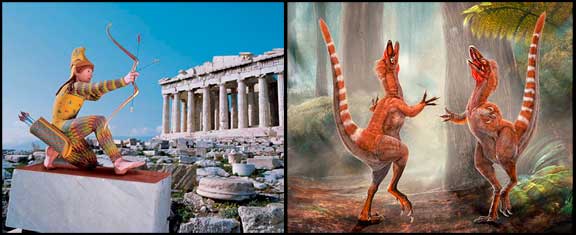Color Matters Blog
Shattering a Colorblind View of the Past

For nearly two centuries, scholars have been arguing that beige and white were not the true colors of antiquity. The Parthenon in Athens and the Forum in Rome might have been almost gaudy. Unfortunately, such ideas have never influenced Hollywood or many experts. For example, in "Gladiator," when Russell Crowe strides down the streets of ancient Rome, circa A.D. 180, he's backed up by the proper complement of white marble. In almost every view of the past, textbooks included, the ancient world comes off as monochrome.
A flood of recent exhibitions has put color back into the vocabulary of antiquity. Last year, "Gods in Color" in Boston and "The Color of Life" exhibition at the Getty featured multi-colored sculptural masterpieces from the Greek and Roman eras.
However, not all scholars are pleased. Of note, Fabio Barry, an art historian at the University of St. Andrews in Scotland, is not overly fond of the Prima Porta sculpture's colored reconstruction. "Can you imagine the family-values, back-to-basics, republican emperor Augustus . . . represented by something that looks like a cross-dresser trying to hail a taxi?" raves Barry, an expert on the history of marble. He insists that the Romans cherished the whiteness of fine marble as an important symbol of light and purity.
On the other hand, Getty Curator Kenneth Lapatin "For the Greeks it was all about mimesis," says, using the Greek word for realistic imitation. Beauty depended on it.
A week ago, scientists revealed something else that shatters our preconceived notions about the drab and dinghy colors of an even more distant past. A team of British and Chinese scientists found evidence that a dinosaur that lived about 125 million years ago had a feathered mohawk with orange-brown bristly feathers around its tail. By examining and comparing tiny structures (melanins) in the feathers, they found the color associated with red-brown. Source
While this colorful development in the lost world of dinosaurs is quite exciting, it will still be left up to our imaginations to create the colors of popular dinosaurs, like Tyrannosaurus rex - at least for now.
As for antiquity, we also need help visualizing and accepting a colored world of architecture and sculpture.
Perhaps this century will colorize the past in amazing ways.
When you subscribe to the blog, we will send you an e-mail when there are new updates on the site so you wouldn't miss them.


